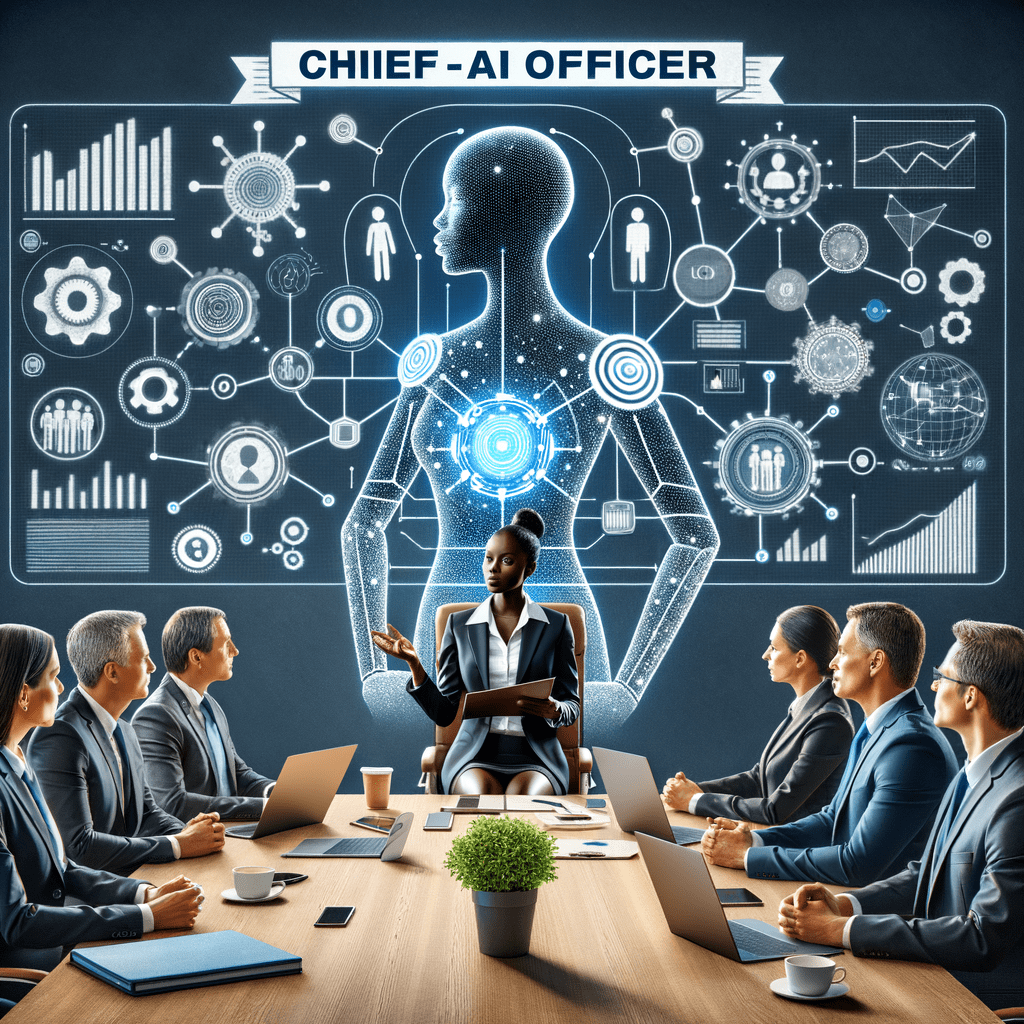What is a Chief AI Officer? Businesses are increasingly seeking leaders to manage artificial intelligence initiatives. This role is vital as companies recognize AI’s transformative power. This article explores the Chief AI Officer role, their duties, necessary skills, and average salary expectations.
What is a Chief AI Officer?
A Chief AI Officer (CAIO) is a senior executive responsible for an organization’s artificial intelligence strategy. They oversee AI technologies’ development, implementation, and governance. The CAIO ensures AI projects align with business goals, integrating AI initiatives across different teams. They also focus on the ethical standards and regulatory requirements of artificial intelligence.
A recent Gartner study found that while many organizations have an AI leader, the title “Chief AI Officer” isn’t universal. This shows the role is growing, even if the title varies. CAIOs establish AI models and cultivate AI talent within their organizations.
The CAIO’s Expanding Role
The CAIO position is relatively new. According to Heidrick & Struggles, 65% of AI-related executive roles are less than five years old. As AI becomes integral to business, a CAIO bridges the gap between technical experts, business units, and customers. They clarify AI’s potential across the organization.
At companies like GE Healthcare and Deloitte, CAIOs guide AI strategy. They identify opportunities for AI applications and integrate AI into existing business processes. One key area is collaborating with product teams and researchers. The goal is delivering AI solutions that improve customer experiences.
A Day in the Life of a CAIO
This role requires both technical and leadership skills. A CAIO is a skilled communicator and strategist. They possess a comprehensive view of AI’s business impact, balancing technological expertise with business needs and ethical considerations. They work closely with data scientists and data officers.
A CAIO might begin by reviewing the latest AI advancements. They could then lead a meeting on ethical implications for future AI projects. They also meet with department leaders to discuss AI-driven business opportunities. In essence, they link complex technology with tangible business results. They may help choose which machine learning and data science tools to implement in projects and privacy policy related areas. They also integrate AI into data science departments while taking into account new technologies such as generative AI, data privacy laws, regulatory requirements, executive orders from the Biden Administration, as well as potential organizational structure changes.
Key Responsibilities and Focus
A Chief AI Officer has several core responsibilities:
- AI Strategy Development: Creating a roadmap for AI integration within the business.
- Overseeing AI Projects: Guiding project teams, tracking milestones, and addressing roadblocks. The CAIO oversees these projects and ensures alignment with the overall AI strategy.
- Collaboration and Communication: Working with other executives, data scientists, data officers and teams. The CAIO works closely with stakeholders to maintain alignment.
- Ethical and Responsible AI: Establishing ethical standards and practices for responsible AI development. The CAIO plays a critical role in ensuring responsible AI usage.
- Staying Ahead of the Curve: Keeping current with AI technologies and industry best practices.
CAIOs advocate for balanced AI adoption, maximizing benefits while minimizing risks. They bring a strategic vision, managing data expertise and modernizing business processes with AI. This includes implementing new AI models, fostering AI talent, and considering data privacy.
The Skills and Expertise Needed for a Chief AI Officer
This senior leadership role demands strong communication and technical expertise. The CAIO ensures that AI technologies align with business goals. They play a critical role in shaping the organizational structure and data privacy policies related to AI.
Technical Skills
- Machine Learning and Deep Learning: Understanding AI algorithms.
- Data Science and Analytics: Expertise in data collection, processing, and interpretation. They often work with chief data officers to leverage data insights.
- AI Platforms and Technologies: Familiarity with various AI platforms.
- Software Development and Engineering: Coding knowledge for collaboration and implementation. CAIOs identify areas for software development related to AI and ensure integration with existing systems. The role requires expertise in areas such as software development and implementing changes that improve operational efficiencies. The role is part executive role, security officer, and includes helping departments make technical decisions. The CAIO’s technical expertise includes deep learning and working closely with machine learning teams. A core part of the role is understanding data privacy, managing risks and threats to security, regulatory requirements, executive orders, as well as other potential compliance issues.
Leadership and Strategic Thinking
- Strategic Vision and Planning: Creating and executing an AI strategy aligned with the company’s mission. This involves establishing an overarching strategic vision for AI, identifying opportunities for AI solutions, and integrating AI into existing business processes. They involves identifying and communicating the role that different employees and executives play to achieve business goals through leveraging technology and working closely with data teams and federal agencies, as necessary. The executive role includes helping departments with software development projects, security considerations, improving operational efficiencies, and digital transformation strategies.
- Communication and Collaboration: Effectively working across teams. They involves identifying key external stakeholders, such as clients, vendors, regulatory bodies, and federal agencies. The CAIO plays an important role in digital transformation, overseeing AI projects, working closely with data teams, ensuring compliance with ethical standards, and regulatory requirements. The CAIO oversees data scientists, integrating their work into the organization’s broader AI strategy.
- Business Acumen: Understanding market trends and using AI to improve operations and customer experiences. The CAIO involves identifying key internal stakeholders, such as business units, technical teams, and data scientists. This involves establishing clear communication channels and fostering collaboration across different teams.
What is a Chief AI Officer’s Salary?
Data on CAIO salaries is still developing. A 2023 survey of 965 global IT decision makers showed 11% of companies had hired a CAIO, with 21% actively recruiting for this position. This indicates increasing demand for Chief AI Officers.
Glassdoor shows limited CAIO salary data, with one U.S. salary at $380,486, including additional pay. A more reliable estimate can be made by comparing to similar roles. The average total compensation for a Chief Technology Officer, a related role, ranges between $207,000 and $387,000, according to Glassdoor.
FAQs about What is a Chief AI Officer?
What is the role of the chief AI officer?
The CAIO leads a company’s AI strategy, linking AI projects with business objectives. They encourage collaboration between different teams and champion ethical AI practices. The CAIO plays a critical role in shaping the organization’s AI governance, ensuring ethical standards and regulatory compliance. The CAIO also identifies and develops AI talent within the organization. CAIO oversees regulatory compliance of any solutions with respect to federal rules.
What is the salary of Chief AI?
CAIO salary data is still emerging. Early Glassdoor data points to approximately $380,000 annually, including bonuses, similar to a Chief Technology Officer’s $276,000 average compensation. However, these numbers are subject to change as the role evolves. Glassdoor more confidently shows that total compensation for a CTO averages $276,000 annually, though this can vary widely depending on factors such as location and company size.
What is an AI officer?
An AI Officer leads a company’s artificial intelligence activities. The title encompasses various roles focused on strategizing, implementing, and managing AI and data teams. AI Officers guide AI development and integration within a business, encompassing responsibilities such as developing AI strategy, overseeing AI projects, and ensuring ethical AI practices. They also include managing and working with chief data and data scientists teams.
How many companies have a chief AI officer?
The CAIO role, under various titles, is growing. A 2023 survey showed 11% of companies had a CAIO, while 21% were actively hiring for one. These numbers continue to grow due to artificial intelligence increasing popularity.
The Evolving Role of the Chief AI Officer
As businesses increasingly adopt AI, the Chief AI Officer’s role is becoming essential. According to Accenture, many view Generative AI as an opportunity. It’s potential for increasing revenue and enhancing customer experiences exceeds its perceived risks. Businesses recognize that implementing AI projects requires not only technical expertise but also thoughtful leadership to navigate the complexities of AI governance, ethical considerations, data privacy, and regulatory requirements.
This growing importance parallels the rise of Chief Technology Officers. The real-world impact of a CAIO lies in balancing opportunities with ethical implications. What does a Chief AI Officer contribute? AI technology is transformative, but its most significant impact lies in its thoughtful, ethical, and customer-centric application. CAIOs ensure that AI technologies serve business goals while upholding ethical standards and protecting data privacy. They work closely with data scientists, data officers, and other stakeholders to ensure that AI projects align with the organization’s overall strategic vision. In the face of increasing regulatory requirements and executive orders, the CAIO’s expertise becomes even more crucial for navigating compliance and ensuring that AI is used responsibly and ethically. This strategic vision requires establishing clear business goals, implementing appropriate AI models, and attracting top AI talent. Their technical knowledge also includes understanding machine learning, artificial intelligence, and data science. As federal agencies appoint their own CAIOs, businesses must also prioritize AI leadership to navigate the evolving regulatory landscape and ensure alignment with government initiatives.
Without a CAIO, integrating AI safely and responsibly becomes more challenging. This role is key to navigating compliance, adapting security policies, and achieving business growth amidst increasing federal regulations. A skilled CAIO leads AI adoption in a way that promotes trust and accountability, protecting organizations from privacy threats. They are vital to ensure AI integration maximizes positive outcomes and drives both business growth and enhanced customer experiences.






